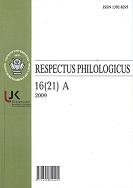JUDĖJIMO ORE SEMANTINĖS GRUPĖS RAIŠKA LIETUVIŲ IR ANGLŲ KALBOSE
THE EXPRESSION OF SEMANTIC GROUP OF MOVEMENT IN THE AIR IN THE LITHUANIAN AND ENGLISH LANGUAGES
Author(s): Saulė Juzelėnienė, Giedrė BaranauskaitėSubject(s): Language and Literature Studies
Published by: Vilniaus Universiteto Leidykla
Keywords: associative semantics; semantic group; lexical semantics;
Summary/Abstract: The article focuses on the expression of semantic group of movement in the air in the Lithuanian and English languages. The contrastive analysis of semantic language groups provides a more generalized worldview in languages than contrasting of separate sememes or words. Since the world has been categorized differently in all languages, the equivalent semantic groups of languages are supposed to be different taking into account their constituting elements and relation between them. Thus, the analysis is carried out referring to two main aspects: how the characteristics of a particular world fragment are reflected in the semantic group, and what the inner structure of the semantic group and its relations with other groups are. The research method employed here is contrastive analysis based on corpus data. The investigation of examples showed quantitative differences of English and Lithuanian verbs which describe movement in the air: in the Lithuanian language there are 24, whereas in the English language there are 17 verbs. The semantic group of movement in the air is quite compact since most of the sememes belonging to this group are close in their meaning. The main direction of the semantic relations with other spheres of the system is centripetal because the semantic group of movement in the air comprises the derived meanings of words of other semantic groups. The major providers are the following spheres: the semantic group of intense physical action, the semantic group of moving from place to place, the words of the semantic group of moving through the water and the verb purpsėti which belongs to the semantic group of sound. This latter group is, however, characteristic just of the Lithuanian language. Since movement in the air is a part of a bigger semantic group of movement in general, the relations with it can be treated as being centrifugal. The analysis revealed that the Lithuanian language tends to use words of other spheres in order to describe movement in the air. In comparison, the English language is more reserved and do not attach so much importance to the movement in the air. Moreover, the Lithuanian language is likely to use more vivid expressions to describe an animate object than the English language.
Journal: Respectus Philologicus
- Issue Year: 2009
- Issue No: 16 (21) A
- Page Range: 135-140
- Page Count: 6
- Language: Lithuanian

